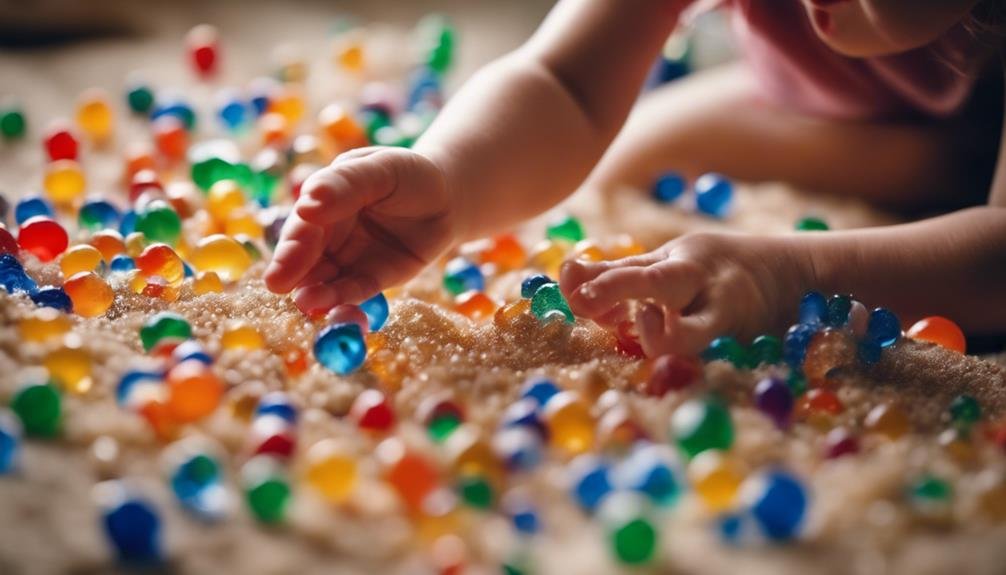Incorporating Sensory Play Into Your Child's Daily Routine
Did you know that according to a recent study, 75% of a child's brain development occurs by age three? Engaging in sensory play can greatly impact this critical developmental period.
By incorporating sensory activities into your child's daily routine, you can enhance their cognitive, emotional, and physical skills in a fun and interactive way.
The benefits are plentiful, and the possibilities for sensory play are endless. From exploring different textures to experimenting with various scents, the journey of sensory play is both educational and enjoyable for your little one.
Key Takeaways
- Strengthen parent-child bond through sensory play.
- Enhance language development and sensory processing skills.
- Promote self-regulation and curiosity.
- Incorporate sensory activities into daily routines for cognitive and emotional development.
Benefits of Sensory Play

Discover the numerous advantages that sensory play offers for your child's development and growth. Engaging in sensory play activities not only stimulates cognitive development but also enhances emotional regulation. By exploring different textures, scents, and sounds, your child's brain is actively making connections that support learning and problem-solving skills. Additionally, sensory play provides a safe space for your child to express and manage their emotions, promoting emotional resilience and self-regulation.
In addition to cognitive and emotional benefits, sensory play also plays an important role in developing social skills and physical coordination. When children engage in sensory activities with their peers, they learn valuable lessons in cooperation, communication, and empathy. These interactions help them build relationships, practice turn-taking, and develop essential social skills. Additionally, sensory play involving movements like pouring, scooping, and stacking helps improve your child's fine and gross motor skills, enhancing their physical coordination and dexterity. Embrace sensory play as a holistic approach to nurturing your child's overall development.
Choosing Sensory Play Materials
When selecting sensory play materials for your child, consider their interests and developmental stage to create engaging and beneficial experiences. By choosing the right supplies and textures, you can enhance their sensory exploration and learning. Below is a table to guide you in selecting sensory play materials that cater to different sensory needs and preferences:
| Sensory Play Supplies | Sensory Play Textures |
|---|---|
| Playdough | Squishy, moldable |
| Water beads | Smooth, slippery |
| Kinetic sand | Grainy, moldable |
Playdough provides a squishy and moldable texture, perfect for enhancing fine motor skills. Water beads offer a smooth and slippery sensation, ideal for sensory exploration and hand-eye coordination. Kinetic sand, with its grainy and moldable texture, encourages creativity and imaginative play. Choose materials that align with your child's interests and developmental goals to create a stimulating sensory play experience.
Setting Up a Sensory Play Area

To create an engaging and sensory-rich environment for your child, consider designing a dedicated sensory play area that caters to their developmental needs and interests. Setting up a sensory play area can provide numerous benefits for your child's growth and development. Here are some practical tips to help you create an effective sensory play space:
- Consider the Space: Choose a designated area in your home where your child can freely explore and engage in sensory activities without assurances.
- Sensory Materials: Stock the area with a variety of sensory materials such as playdough, sand, water tables, textured fabrics, and musical instruments to stimulate different senses.
- Organization: Keep the play area organized with labeled bins or shelves to make it easy for your child to access and put away sensory materials independently.
- Safety Measures: Assure that the play area is safe for your child by removing any choking hazards, securing heavy furniture, and using non-toxic materials.
Sensory Play Ideas for Different Ages
Consider the developmental stages of children when exploring sensory play ideas for different ages to guarantee engaging and appropriate activities that support their growth and learning.
For infants and toddlers, focus on mess-free activities like playing with textured fabrics or safe-to-eat sensory bins. As they grow into preschoolers, introduce creative alternatives such as homemade playdough with different scents or a sensory scavenger hunt using various textures.
Interactive games are perfect for school-age children, such as sensory obstacle courses or sensory storytelling where they can engage both their minds and bodies. For preteens and teenagers, consider educational fun like science experiments involving touch or art projects using different mediums.
Incorporating Sensory Play Outdoors

Enhance your child's sensory experiences by taking their play outdoors, where nature provides a wealth of stimulating elements to engage their senses. Nature exploration and outdoor adventures offer a unique and enriching sensory experience for your child. Here are some practical ways to incorporate sensory play outdoors:
- Sensory Scavenger Hunt: Create a list of items for your child to find based on different textures, smells, and colors. Encourage them to touch, smell, and observe each item they discover.
- Messy Play with Nature: Allow your child to explore mud, sand, leaves, and water. These natural elements provide diverse tactile experiences that can be incredibly stimulating.
- Outdoor Art: Encourage your child to create art using materials found in nature, like leaves, flowers, or rocks. This activity engages their sense of touch and sight in a creative way.
- Nature Soundscape: Sit quietly with your child and listen to the sounds of nature around you. Ask them to identify different sounds and discuss how each makes them feel.
Sensory Play for Special Needs Children
Take your child's sensory play experiences to the next level by customizing activities to cater to their unique needs and abilities, particularly for special needs children. When engaging in sensory play with special needs children, focusing on interactive games and utilizing therapy tools can enhance their experience and development. Here are some practical examples to guide you:
| Interactive Games | Therapy Tools |
|---|---|
| Sensory scavenger hunts | Weighted blankets |
| Musical chairs with tactile cushions | Therapy putty |
| Texture exploration bins | Visual timers |
These activities can help special needs children improve their sensory processing skills, regulate their emotions, and enhance their engagement with the world around them. By incorporating these tailored sensory play experiences, you can create a supportive environment that promotes growth and learning while having fun together.
Sensory Play Safety Tips

To guarantee a safe and enjoyable sensory play experience for children, prioritize supervision and appropriate materials. When engaging in sensory play activities, remember these safety tips:
- Sensory play supervision: Always monitor children during sensory play to make sure they're using materials safely and not putting anything harmful in their mouths.
- Precautions: Be cautious with small items that could be a choking hazard and avoid materials that may cause allergic reactions or skin irritations.
- Sensory play equipment: Regularly check sensory play equipment for any damage or wear and tear that could pose a safety risk to children.
- Maintenance: Clean and sanitize sensory play materials regularly to prevent the spread of germs and guarantee a hygienic play environment for your child.
Making Sensory Play a Daily Habit
As you aim to incorporate sensory play into your child's daily routine, consider introducing simple activities that engage their senses and spark curiosity. Sensory exploration can be seamlessly woven into your child's day, enhancing their cognitive development and overall well-being.
To make sensory play a daily habit, start by setting aside dedicated time each day for these activities. It could be during playtime, before bedtime, or even while preparing meals together. Engaging your child's senses regularly won't only provide them with fun and stimulating experiences but also strengthen your bond through shared moments of discovery.
Daily engagement in sensory play doesn't have to be elaborate or time-consuming. Simple activities like playing with different textured materials, exploring nature in your backyard, or creating sensory bins with everyday objects can offer valuable sensory stimulation.
Frequently Asked Questions
How Can Sensory Play Help Children With Sensory Processing Disorders?
Sensory play offers therapy benefits to children with sensory processing disorders. It aids in sensory integration, helping them regulate their responses to stimuli. Engaging in such activities can provide a safe and enjoyable way for them to explore and understand their senses.
Are There Any Specific Sensory Play Materials to Avoid for Children With Allergies or Sensitivities?
When considering sensory play materials for kids with allergies or sensitivities, it's important to avoid common triggers like latex, nuts, and strong scents. Prioritize safety by choosing hypoallergenic options to guarantee your child benefits from sensory play without any adverse reactions.
What Are Some Signs That a Child May Not Be Enjoying or Benefiting From Sensory Play?
Noticing signs a child dislikes sensory play? Observe their reactions closely. Lack of parental involvement, aversion to specific textures, or communication cues like withdrawal could indicate discomfort. Offer alternative activities to cater to their sensory preferences.
Can Sensory Play Be Incorporated Into a Child's Routine at School or Daycare?
You can absolutely incorporate sensory play into your child's school or daycare routine. While it offers numerous benefits like boosting creativity and problem-solving skills, there might be limitations due to space or resources. However, with some creativity, it can be adapted for group settings.
How Can Parents Encourage Older Children to Continue Engaging in Sensory Play Activities?
To encourage older children to engage in sensory play, consider linking it to school projects. For instance, creating a tactile model for history class. Additionally, integrate sensory elements into outdoor activities like scavenger hunts, adding a fun twist to learning.
Conclusion
As you sprinkle sensory play into your child's daily routine, you're planting seeds of growth and exploration. Like a colorful garden blooming with possibilities, these simple activities can nurture their imagination and development.
Embrace the mess, the laughter, and the curiosity that sensory play brings. Watch as your little one blossoms into a confident, creative individual, one sensory experience at a time.
Let the world be their playground, filled with textures, sounds, and endless discoveries.







